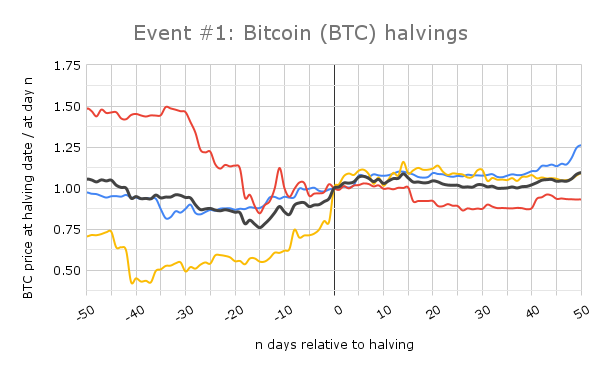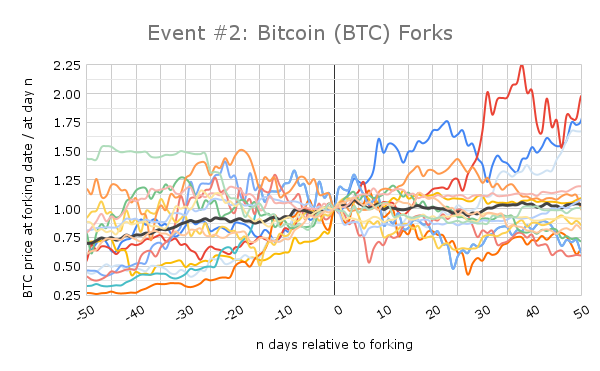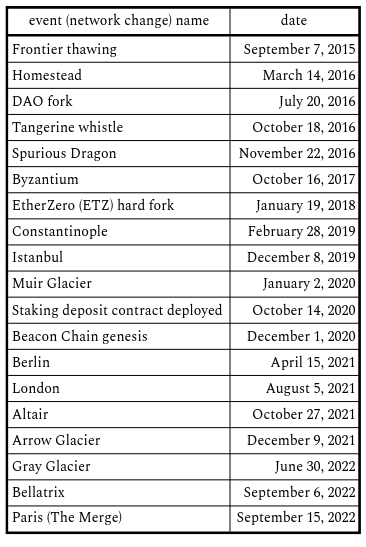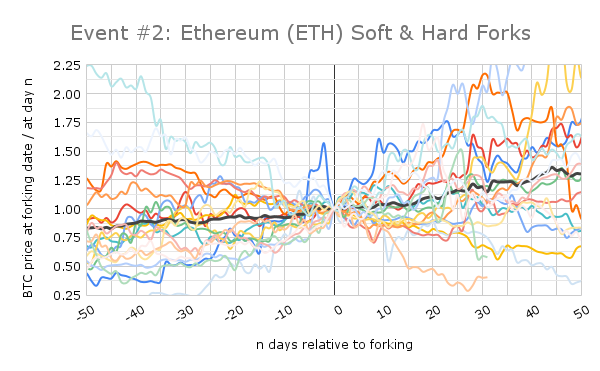
Introduction
Cryptocurrencies are a high-risk and very speculative asset class that, from being used only by tech geeks worldwide, spread from small retail craziness of early adopters to institutional adoption and mainstream. Some claim it to be a world-changing concept with the utilization of blockchain (databases) and smart contracts that open a wide range of opportunities, from decentralizing finance to self-governing algorithms; some others point to unnecessary scams, money laundering, and bubbles. Comparing it to Tulipmania in the Netherlands, there’s no doubt that lax financial conditions inflated cryptocurrencies to a massive market cap.
We have been covering the concepts and topics relating to crypto extensively. Do not miss checking our previous cryptocurrency research and the findings from the interesting papers on our blog. This article will continue our investigation of this interesting field. We would like to test how the price action looks around some of the events unique to the cryptocurrency world – namely the Bitcoin reward halvings and hard and soft forks in Bitcoin and Ethereum networks.
Related Research in Traditional Finance
There are numerous seasonal/calendar trading strategies (Holidays effects, trading Fed’s (FOMC) decisions, Turn of the Month, …, options expirations, CPI, NFP, PPI releases). We have already covered a lot of them and transferred some ideas from traditional assets (like equities, bonds, or commodities) to cryptocurrencies (for example, see Overnight Seasonality in Bitcoin). With the commercialization of the cryptocurrency space, more and more traditional seasonal/calendar anomalies are becoming important. It is because some of the more conservative bigger investors have taken a stake, mainly in most capitalized cryptocurrencies, so we can expect them to move with more traditional assets according to global trends in growth, inflation, and monetary and fiscal policies.
But in this case, we would like to conduct an exploration of the crypto calendar anomalies unrelated to the global financial markets. So let’s move on …
Event #1: Bitcoin (BTC) halvings
Bitcoin has one important pre-programmed feature in its source code: The reward miners receive for including transactions into a block is not permanent. After every 210,000 blocks mined, the block reward is halved. This event occurs about once every four years and is called “halving.” So far, there have three big halvings.
The first halving took place on 28 November 2012, the second one on 9 July 2016, and finally, the last third halving was on 11 May 2020. We expect the 4th halving to be in the first half of 2024 (between February and May). Data for 2012 halving were downloaded from Coincodex. Data for other halving and following research are from our internal price database.
The following figure depicts price action around all the abovementioned halvings that have taken place so far:

As we can see from the figure, and especially from the average of all halvings’ results, the price action in all three cases has been very similar – a slight price depreciation from day -50 to around day -15 before the halving event and then price appreciation up until around day +10 after the halving event. However, the most notable observation is that the price volatility is significantly higher before halving (before the information is digested) and suppressed after the event.

From a trader’s perspective, it would be constructive to conduct swing trade in the style of the adage “buy the rumor, sell the news,” even if the event is quite known beforehand. Unfortunately, we have only a small sample of events to really build a rigorous trading strategy, so it’s more of a speculation. Would such a strategy be applicable in 2024? The time will only tell, and while past results do not indicate future results, it would not be unreasonable to closely follow price action in Bitcoin prices and speculatively build a small long position before the halving event.
Event #2: Soft & Hard Forks
Binance Academy explains the biggest difference between soft and hard forks, and we will take a helping hand from them: Hard forks are backward-incompatible software updates. Typically, these occur when nodes add new rules in a way that conflicts with the rules of old nodes. New nodes can only communicate with others that operate the new version. As a result, the blockchain splits, creating two separate networks: one with the old rules and one with the new rules.
So there are now two networks running in parallel. They’ll continue propagating blocks and transactions, but they’re no longer working on the same blockchain. All nodes had an identical blockchain until the point of the fork (and that history remains), but they’ll have different blocks and transactions afterward. Because there’s that shared history, you’ll end up with coins on both networks if you were holding them before the fork. Suppose that you had 5 BTC when a fork occurred at Block 600,000. You could spend those 5 BTC on the old chain in Block 600,001, but they haven’t been spent in the new blockchain’s Block 600,001. Assuming the cryptography hasn’t changed, your private keys still hold five coins on the forked network. All network nodes must upgrade if a blockchain goes through a hard fork. Only the latest version participating in the network is considered valid. Unlike with a soft fork, this is not forward compatible – the rules of the old blockchain will not accept the new blocks.
A soft fork is a backward-compatible upgrade, meaning that the upgraded nodes can still communicate with the non-upgraded ones. What you typically see in a soft fork is the addition of a new rule that doesn’t clash with the older rules. For example, a block size decrease can be implemented by soft-forking. Let’s once again draw on Bitcoin to illustrate this point: though there’s a limit on how big a block can be, there isn’t a limit on how small it can be. If you want only to accept blocks below a certain size, you just need to reject bigger ones. A soft fork is a forward-compatible change to the rules. It doesn’t create a new blockchain. Instead, it maintains the old blockchain by running on two lanes with different sets of rules.
Simply put, the old blockchain can accept blocks from the new protocol rule changes. New rules allow a subset of the previous valid blocks, so updated as well as old blocks of transactions are valid at the same time.
Bitcoin (BTC)
Now, let’s now take a look at some hard and soft forks applied to the most famous cryptocurrency out there, Bitcoin. We found and used the list of the most prevalent Bitcoin forks from https://findmycoins.ninja/, which is expanded by some older and newer forks to take other periods into account:
| ticker | Name | Fork date | Block # | 1 BTC = |
|---|---|---|---|---|
| – | Bitcoin XT | Aug. 15, 2015 | – | – |
| – | Bitcoin Classic | Feb. 9, 2016 | – | – |
| BCH | Bitcoin Cash | Aug. 1, 2017 | 478559 | 1 BCH |
| BCL | Bitcoin Clashic | Aug. 1, 2017 | 478559 | 1 BCL |
| BSV | Bitcoin SV | Aug. 1, 2017 | 478559 | 1 BSV |
| BTG | Bitcoin Gold | Oct. 24, 2017 | 491407 | 1 BTG |
| BTX | Bitcore | Nov. 2, 2017 | 492820 | 0.5 BTX |
| BCD | Bitcoin Diamond | Nov. 24, 2017 | 495866 | 10 BCD |
| LBTC | Lightning Bitcoin | Dec. 18, 2017 | 499999 | 1 LBTC |
| BIFI | BitcoinFile | Dec. 27, 2017 | 501225 | 1000 BIFI |
| BPA | Bitcoin Pizza | Dec. 31, 2017 | 501888 | 1 BPA |
| BCA | Bitcoin Atom | Jan. 25, 2018 | 505888 | 1 BCA |
| BTCP | Bitcoin Private | Feb. 28, 2018 | 511346 | 1 BTCP |
| BCL | bitcoinClean | April 18, 2018 | 518800 | 1 BCL |
| MBC | Micro Bitcoin | May 29, 2018 | 525000 | 10000 MBC |
| BZX | Bitcoin Zero | Aug. 31, 2018 | no info | 1 BZX |
| BPQ | Bitcoin Post-Quantum | Dec. 22, 2018 | 555000 | 1 BPQ |
To represent some samples of (soft) network upgrades, we also include Taproot, which took place on November 14, 2021, and was meant to streamline the processing of transactions and make them more efficient in speed and cost.
Results from forking events are very similar to ones from halvings. On average, the price appreciates before the event and stays relatively flat after the event. What’s different from halving is the volatility – Bitcoin is significantly volatile before and also after forks.


Ether (ETH)
All Ethereum (ETH) upgrades (soft forks) can be seen at https://ethereum.org/en/history/. Apart from that, we cover price action around the dates of the most famous hard forks: the launch of Ethereum Classic (ETC) on July 20, 2016, which is also known as DAO fork, and EtherZero (ETZ), which was launched on January 19, 2018.
The summary of ETH network change events is in the following table:

Chart depicting price action around previously mentioned network upgrades, including soft and hard forks:

On average, ETH tends to rise steadily before the event but with slower growth than in the case of BTC. What is more apparent than in the case of BTC is the price appreciation also after the event.
And we also include a table presenting the results of network upgrades:

Short Conclusion
Our short research shows that events related to changes in cryptocurrency algorithms can give market participants interesting trading and investing opportunities. But please, hear a word of caution. We have a short sample of events as the cryptocurrency market is young and doesn’t have a long history. Additionally, as the table and charts indicate, the dispersion in the performance before and after the events is significant. We can use results as a guide for tactically building long-term positions to the long side. But great caution is needed if someone would like to trade those events independently since the noise around events is high.
Author:
Cyril Dujava, Quant Analyst, Quantpedia
Are you looking for more strategies to read about? Sign up for our newsletter or visit our Blog or Screener.
Do you want to learn more about Quantpedia Premium service? Check how Quantpedia works, our mission and Premium pricing offer.
Do you want to learn more about Quantpedia Pro service? Check its description, watch videos, review reporting capabilities and visit our pricing offer.
Are you looking for historical data or backtesting platforms? Check our list of Algo Trading Discounts.
Would you like free access to our services? Then, open an account with Lightspeed and enjoy one year of Quantpedia Premium at no cost.
Or follow us on:
Facebook Group, Facebook Page, Twitter, Linkedin, Medium or Youtube
Share onLinkedInTwitterFacebookRefer to a friend

















